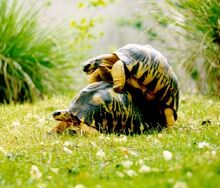Turtle
| Turtle | |
|---|---|
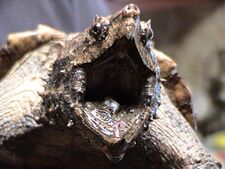 A turtle's roar can be heard up to 10 miles away, making them the loudest animals known to man. A turtle's roar can be heard up to 10 miles away, making them the loudest animals known to man. | |
| Scientific classification | |
| Kingdom | Animalia |
| Class | Reptilica |
| Order | Lizardus |
| Family | Hermitus |
| Species | Lizardus Hermitus |
| Binomial name | |
| Tank Lizards | |
| Specifications | |
| Weight | 5 ounces to 2 tons |
| Length | 2 inches to 3 feet |
| Special attack | Turtle Power |
| Conservation status | |
| Conserving energy for the next attack | |
Turtles are lizards in the half-shell. A turtle can retreat inside the shell for warmth, safety, and to catch the soaps. Subspecies of turtle include common turtles, snapping turtles, sea turtles, and Teenage Mutant Ninja Turtles.
Turtles are one of Earth's oldest species, essentially fossils without the unpleasant chore of dying. Their shells kept them from being overhunted into extinction by dinosaurs, and even today, keep them from being mistaken for porcupines. The shell is the reason why some tortoises are over 65 million years of age.
Etymology
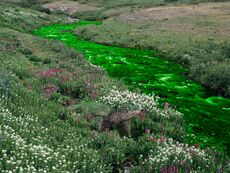
The word turtle is derived from the Old English word turdyl, meaning "little turd". This is because the people of the Middle Ages believed turtles actually originated from sewage dumped into the Thames; feces floated on top of the water, where Medieval scientists thought the upper part dried out and hardened into a crust from exposure to the atmosphere, then through the miracle of spontaneous generation, a head and limbs would pop out the sides.
It was not until the early 1700s that biologists first reclassified turtles as a type of amphibian, bringing them one step closer to their modern classification as lizards in 1985. However, the name stuck, albeit with updated spelling.
Evolution
Turtles first evolved when a cowardly lizard took refuge underneath a rock, and carried it around on its back. However, the rock was heavy, which made the lizard's movements slow. Future generations took to instead eating rocks and growing a mineralized shell; this new, lighter shell might have enabled faster movement had the turtles not also gotten fatter to fit inside their new mobile homes.
In prehistoric times, few predators would attempt to bite through this shell, save for Tyrannosaurus rex. This dinosaur evolved its huge jaws specifically for crunching through turtle shells. It is theorized by paleontologists that T. rex's love of turtles was so great, it would ignore entire herds of perfectly good Stegosaurus or Brontosaurus just to focus on a five-inch turtle swimming in a nearby creek. Fortunately for the turtle, T. rex was made extinct by a giant asteroid, allowing the tiny reptile to survive into the modern era.
Anatomy and morphology
The anatomy of a turtle is very similar to that of a lizard, with the exception of the hard shell on the ventral and dorsal sides of the animal. This shell is composed of mineralized tissue, the same substance which is used in jawbreakers.
A common misconception is that a turtle's shell is attached to its skeleton, preventing its removal. In reality, turtles traditionally use Super Glue to permanently attach them, to avoid misplacing them. Some turtles nowadays use Velcro or magnets as an alternative, especially if they plan on moving into a nicer shell later on.
The difference between turtles and tortoises
There is an important distinction to make between turtles and tortoises, since these terms are often erroneously used interchangeably. Also, a common misconception is that turtles are merely the waterborne variant of tortoises.[1]
Turtles have several key evolutionary advantages over tortoises:
- Turtles can swim, but tortoises can't.[2]
- "Turtle" has fewer letters in it than "tortoise", making it more efficient to type.
- Turtles are more popular than tortoises.
This brings up the question of why tortoises evolved in the first place. The answer is that tortoises tend to have larger shells. In this extra living space, they can place additional expensive appliances, such as widescreen HDTVs, which improves their overall quality of life. Any turtle can become a tortoise by simply moving up on the socioeconomic ladder and eventually buying a roomier shell to move into.
However, if a turtle cannot advance into a higher class, it will lose its shell to foreclosure and have to move into a smaller dwelling, such as a seashell. It will never be content with its tiny home though, and will periodically seek slightly larger ones to move into. This explains the evolutionary origins of the hermit crab.
Diet

The main portion of a turtle's diet consists of lettuce, which they eat to gain the chlorophyll needed for photosynthesis. Turtles need to stay fat enough for their shells to fit snugly, so they require approximately 25 pounds of lettuce every 2 hours if kept as a pet. Some turtles will also eat worms or fish, especially gummy ones which come in a plastic bag.
Turtles could be called strict vegetarians, except for the occasional pizza consumed by adolescents and the snapping turtle's tendency to go after human fingers and toes. However, much like sharks mistaking human prey for seals or Jaws actors, snapping turtles may eat human fingers only if they smell Cheetos dust still on them. Why snapping turtles will also attack toes is a mystery that many herpetologists would prefer not to investigate.
Behavior
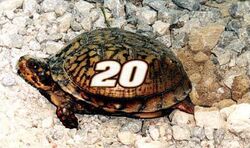
Turtles typically don't do much. They often prefer to spend their time basking in the sun or under a heating lamp. This is because their shells double as solar panels, allowing them to store the light and heat as electrical energy in an organic battery hidden under the top shell. When the situation calls for it, turtles can release this energy all at once into their leg muscles, enabling acceleration to top speeds of approximately 87 miles per hour. This is fast enough to escape cheetahs (one of their top natural predators since T. rex died out), but not fast enough that they time travel.
This fact remains little-known because of turtles' general perception of being slow. This is because this special ability takes a long time to energize beforehand, and they try to conserve energy whenever possible to help their internal batteries charge faster.
It is recommended to leave opening a turtle's shell to a licensed veterinarian or electrician. The batteries can store large amounts of charge, which can cause serious injury or death if it is allowed to leak.[3][4]
The African Giant Tortoise
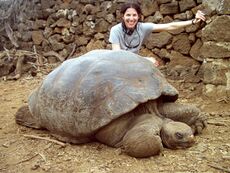
One subspecies which takes the solar charging ability to the extreme is the notorious African Giant Tortoise, which is native to the Savannah grasslands. Since its habitat lies along the Equator, this tortoise is exposed to abnormally high levels of sunshine, which charges it up faster than usual. It also has a heavy, massive shell, which is used to hold not HDTVs but an even larger array of bioelectric batteries, which can store enough charge to power roughly 2,000 homes for a year.
As Charles Darwin once wrote in his scientific journal about this creature, "[t]here is simply no way such a powerful creature could be content remaining an herbivore."[5] The African Giant Tortoise makes good use of all this surplus energy to charge at and take down the cheetahs which would normally prey upon it. Hippos and crocodiles mostly stay within rivers to avoid being targeted by the Giant African Tortoise, which fortunately cannot swim.
The African Giant Tortoise's favorite prey are actually elephants; once these tortoises reach 87.999 miles per hour while charging at an elephant, they use their powerful hind legs to jump over 40 feet through the air, aiming themselves at the elephant's forehead. The massive kinetic energy stored in the hard shell is more than enough to make the elephant's skull a splode. The tortoise then calmly crawls over to lap up the tasty brains scattered everywhere. These attacks are theorized to be the main cause of several elephant herds' declining numbers, rather than poachers as previously thought.
Reproduction
After reaching sexual maturity, turtles will periodically emit a mating call to locate potential mates. Turtles might be hiding in their cozy shells, or listening to music on headphones, when the sound reaches them. For this reason, it needs to be loud enough to get through to the occupant's earholes, regardless of any physical barriers. Thus, turtles have the loudest known mating call in the animal kingdom, which can reach volume levels similar to the eruption of Krakatoa. Their mating roar has been known to not only drown out the sound from nearby jet engines, but also subject them to such turbulence that they shake apart in midair and crash the plane. The FAA marks the airspace over turtle habitats as off-limits during mating season for this reason.
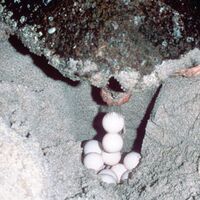
After the turtles find each other and mate, the female digs a hole in the ground to lay a cluster of eggs. There can be up to 150,000 eggs in a single hole, which explains how they can breed like rabbits. Because of their substantial litter size, turtles can easily wreck local ecosystems through overpopulation if cheetahs are not present. Sea turtles can be especially productive, laying over 2 million eggs in the span of one hour; these eggs are then carefully covered up with sand castles to prevent predation.
Sea turtle eggs and the sports industry
The sports equipment industry traditionally harvested some of these eggs for their round shape and light bounciness. These qualities make sea turtle eggs highly desirable as ping-pong balls, having previously standardized on ostrich eggs. In the early 2000s, the increasing popularity of beer pong drove up demand for ping-pong balls. Companies responded by harvesting even more sea turtle eggs to try and keep up with the market. Unsustainable business practices nearly drove the sea turtle to extinction by 2010, and in 2012 they became a protected species.
Most ping-pong balls available today are now made with molded plastic. However, the illegal harvesting of sea turtle eggs continues, where many are sold on the black market in Great Britain. If British beer pong players land a ball in a cup and find a baby turtle swimming in their Budweiser, they are encouraged to stop buying that brand of ball and flush the turtle down the toilet. British toilets still drain directly into the Thames; from there, baby sea turtles can find their way back into the ocean, providing the chemical pollution doesn't kill them first.
Habitats and range
Turtles are among the most prolific and varied species of animal on Earth. They can be found virtually anywhere, from the frozen Arctic tundra to the plains of the Savannah. They are an example of what biologists call an "extremophile", meaning they can be found in such challenging habitats as inside volcanoes or in sewers.
Although they are generally quite common around the world, turtles are nearing "threatened" species status in the People's Republic of China, where they are regularly eaten as turtle soup since their 1700s reclassification.
See also
References
- ↑ However, if this were the case, this article would simply be titled "Tortoises", yet it isn't.
- ↑ This can be verified at home, making it a classic children's science experiment.
- ↑ This could also void the turtle's warranty.
- ↑ The term "shellshock" actually came about to describe electrocution from improperly opening a turtle shell.
- ↑ Darwin, after seeing just one African Giant Tortoise, wisely decided to go to the Galapagos Islands to study the tortoises residing there instead.
| Featured version: 7 April 2015 | |
| This article has been featured on the main page. — You can vote for or nominate your favourite articles at Uncyclopedia:VFH. | |

